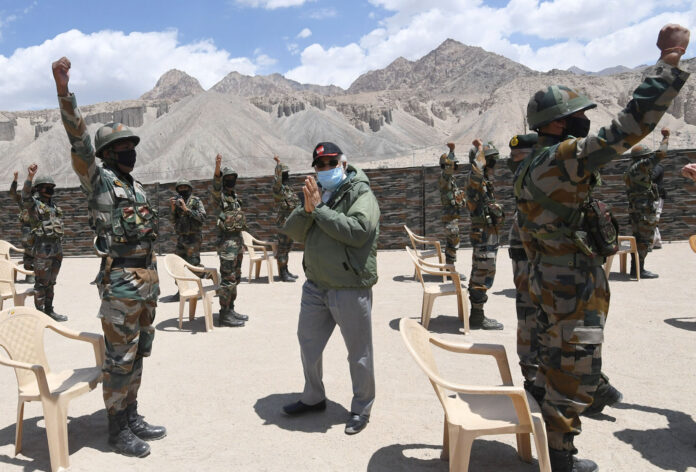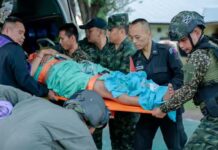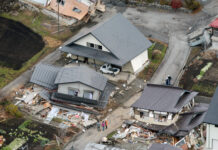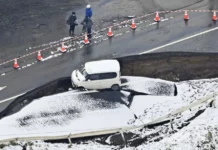HONG KONG: The bloody combat operations occurring in Ukraine and Gaza, plus the tensions heating up in the South China Sea, dominate news headlines and make it easy to forget that the People’s Liberation Army (PLA) – China’s armed forces – continues to strengthen its position along China’s southern border with India.
In the Annual Threat Assessment of the US Intelligence Community, published earlier this year, border tensions between China and India merited only a single paragraph amidst all the other conflicts, threats and tensions that currently abound in the world.
Nonetheless, the report assessed that “The shared disputed border between India and China will remain a strain on their bilateral relationship.”
It continued, “While the two sides have not engaged in significant cross-border clashes since 2020, they are maintaining large troop deployments, and sporadic encounters between opposing forces risk miscalculation and escalation into armed conflict.”
In April this year, the Strategic Studies Institute of the US Army War College published an in-depth report examining PLA activity along the mountainous border in Aksai Chin opposite India in 2020-21. The author, Dennis Blasko, primarily considered how the PLA rapidly moved troops into the region as violence flared between Chinese and Indian troops in Galwan Valley on 15-16 June 2020. However, Blasko, a former US defence attache in Beijing and Hong Kong, also provided a useful assessment of current and future conditions along the Line of Actual Control (LAC).
He assessed, “Barring negotiations with the Indian military and government to withdraw out-of-area combat troops, the PLA appears ready to maintain its deployments near the LAC in Aksai Chin and on the border at Doklam indefinitely.”
He continued: “In the case of Aksai Chin, due to the challenges of transporting large mechanized units over long distances, rotations of units into and out of the region will likely occur after a prolonged tour of duty (perhaps six months to a year or more). The situation has taken the form of PLA border operations against Vietnam following the 1979 war until 1987, albeit with fewer troops and less actual combat and artillery bombardment.”
He pointed out that the Chinese army’s “extended border reinforcement operations serve both political and military purposes, and provide the units and staffs in the Western Theater Command with real-world operational and logistics experience that cannot be achieved through routine peacetime training”.
Unfortunately, little is known about how PLA units prepare for, assemble and travel to and from their home bases to the LAC. Once in position, these units are sustained by supply depots more than 1,600km away. Incidentally, the Western Theater Command defends nearly half of China’s landmass with just a quarter of the PLA ground force’s total troops. The theater command possesses two group armies, plus the Xinjiang and Tibet Military Districts, which are equipped unlike any other PLA provincial military district.
Blasko made heavy use of Google Earth satellite coverage of the Aksai China area in his research for the US Army War College, and because some imagery is not up to date, he could not provide a reliable assessment of current deployments. He said, “Although China’s state media continues to report on units on the ‘front line’ or in ‘battle positions’ in the Karakoram region (without specifying Aksai Chin), it has done so without revealing the total number of troops deployed or their exact locations.”
Nonetheless, the former US officer assessed that “enough fortified positions were constructed in the various PLA-controlled sectors since the spring of 2020 to support a full division-size deployment – or roughly 10,000 personnel – on top of the two border defence regiments (approximately 5,000 personnel) already assigned to the region. Further, these units are reinforced by engineer, artillery and support elements (probably numbering several thousand more personnel).”
In all, he calculated the PLA has approximately 20,000 soldiers arrayed over 400km front in Aksai Chin, in a zone reaching back more than 32km from the LAC.
Furthermore, “This number may be higher during the period in which an out-of-area unit that has spent time on the LAC rotates out and is replaced by a fresh unit entering the area. Nonetheless, the 20,000 figure is a considerably smaller estimate of PLA personnel deployed in the disputed region than the 40,000-60,000 frequently asserted in non-Chinese media.”
Perhaps comfortingly, Blasko concluded that 20,000 troops scattered across such a broad front is “inadequate to conduct a large-scale offensive across the difficult terrain delineated by the LAC”. Any offensive would necessitate a build-up of units and supplies if the PLA were to attempt a substantial incursion beyond the border. For defensive operations, PLA doctrine recommends a divisional front that is 15-20 km wide and 20-30 km deep. For offensive operations, that front would sharpen to be some 5-8km wide and 4-8km deep. Obviously, the disposition of Chinese troops along the LAC is nowhere close to that at present and, even at the peak of tensions in mid-2020, the front was in fact some 160km wide from Galwan Valley to Rechin La.
At that time, the PLA’s combined-arms regiment deployed to Galwan was lined up in a valley less than quarter of a mile wide, and separated by more than 50km from the nearest combat unit. Likewise, two combined-arms regiments in the south deployed over a 40km front, separated by Pangong and Spanggur Lakes, so they could not mutually support each other via land manoeuvres.
Of course, the terrain in that rugged, high-altitude part of the world does not favour large-scale armored or mechanized combat operations. This is because mountains and valleys channel advances and prohibit lateral movement.
Asked about the terrain, Blasko told ANI: “I just don’t think they want to pack too many troops and vehicles into such bad terrain, because they’d just make lucrative targets if fighting actually starts – lucrative to air, missile or artillery attack. In a prolonged conflict, this is light infantry terrain where people will be trying to gain control of ridges, hilltops and areas for long-range observation. In most areas, the new tanks and armored personnel carriers and everything else would really be constricted. This is a very, very tough place to operate, even when you have air and artillery support.”
Blasko also pointed out in his detailed report that “PLA units have been positioned to consolidate and hold territory, to conduct patrols and protect construction projects, and to create ‘facts on the ground’, similar to the reef expansion operations in the
South China Sea a decade ago.” Indeed, the PLA is “prepared to stay in the region for as long as it takes for the two governments to negotiate a solution.”
Actually, there are many similarities between China’s aggressive modus operandi along the Indian border and its nefarious reef-building and territory-grabbing activities in the South China Sea.
Speaking of which, the confrontation between the China Coast Guard (CCG) and the Philippines near Second Thomas Shoal on 17 June came precipitously close to armed conflict. It was the most serious confrontation ever recorded between the two sides, as CCG personnel attempted to prevent resupply of the Philippine military garrison on the beached BRP Sierra Madre vessel there. Chinese personnel operated extremely close to the grounded ship at Second Thomas Shoal, and then proceeded to wield knives and an axe, and ram a Philippine boat in an action that resulted in a Philippine sailor losing a thumb. China seized a Philippine rubber dinghy and confiscated firearms during the confrontation.
China claimed that the CCG exercised restraint and acted “professionally and reasonably” in this skirmish, despite extremely contrary video evidence released by Manila. China’s violent actions so close to the Sierra Madre, just short of boarding it, demonstrate how it is escalating tensions and testing Manila’s red lines. In fact, its seizure of another military’s boat could perhaps legally be construed as an act of war.
Earlier this year, President Ferdinand Marcos Jr warned that the Philippine-US Mutual Defense Treaty could be invoked if a civilian or serviceman is killed in these fiery exchanges in the South China Sea. Beijing is presently flirting with that possibility.
The Philippine personnel under attack on 17 June were from the Naval Special Operations Command, and they could easily have fought back against the lesser-trained CCG. The Philippines thus exercised remarkable restraint, and its troops also refrained from firing warning shots. This is because Manila is wary of China baiting it into escalatory behavior. On 23 June, Marcos told personnel watching over the South China Sea that the Philippines is “not in the business to instigate wars”.
Unfortunately, however, this whole incident reinforced to Beijing how Manila is reticent about escalating tensions, and that the US is reluctant to get more heavily involved. China’s probes are discovering that Philippine red lines are quite stretchy and flexible. Of course, China uses the same probing tactics along the LAC, but India has demonstrated that only ongoing and robust action can dissuade China from its bullying provocations.
Doklam along the Sino-Indian border was another site where Indian and Chinese troops clashed in 2017, and Blasko highlighted how the situation there exhibited similar, but smaller, characteristics. The American observed: “Based on my analysis of Google Earth imagery, the Tibet Military District light combined-arms brigade located in Yadong County has established protected positions to reinforce border defence units stationed along the border with Bhutan. But likely only one reinforced combined-arms battalion at a time of the combined-arms brigade is deployed on about a one-mile-wide front at Doklam to a depth of about three miles. Forward-deployed units are supported by the brigade’s artillery battalion operating from newly built hillside bunkers to the rear.”
After the Galwan Valley clash, units from the Xinjiang Military District reinforced the two border defense regiments already stationed in Aksai Chin. Over the next six months, the PLA established fortified defensive positions along the LAC. The latter activity was known as the 506 Special Mission, and since then has involved ongoing rotational deployments. Blasko shared: “Until a negotiated political settlement is reached, the Western Theater Command is prepared to sustain the rotation of units into and out of the region in the largest near-combat deployment since the end of the border conflict with Vietnam in 1987.”
China has been feverishly beavering away on creating new infrastructure, such as two bridges it put across the narrowest part of Lake Pangong. One bridge is estimated to be 6m wide and the other 11m wide, able to support the movement of troops, equipment and supplies. China has also been building a road from the bridge to the Moldo garrison and PLA base camp behind Lake Spanggur, which would facilitate faster tactical deployments of troops.
To better prepare troops for living in such high-altitude areas, the PLA Tibet Military Command and the Department of Highland Military Medicine of the PLA Army Medical University launched a pilot program for low-pressure hypoxia cabin acclimation training for recruits before they deploy.
According to Chinese media, this training has improved acclimatization and permitted operational deployments in shorter periods of time. The PLA has even created “vegetable factories” at altitudes as high as of 5,270m to provide border defence troops with fresh greens.
Asked earlier whether further border confrontations could happen along the Sino-Indian border, Blasko told ANI, “Yes, I think there’s a possibility of conflict, especially as small units come into close proximity with each other. There are probably a lot of low-level people on both sides looking for a fight.” (ANI)
Also Read: Indian Air Force to carry out Ex Trishul along China, Pak borders from next week







